The Professional Slingshot: Mastering Kiteboarding
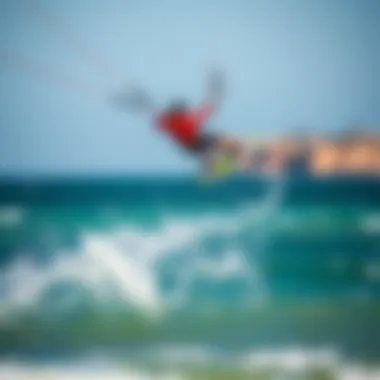
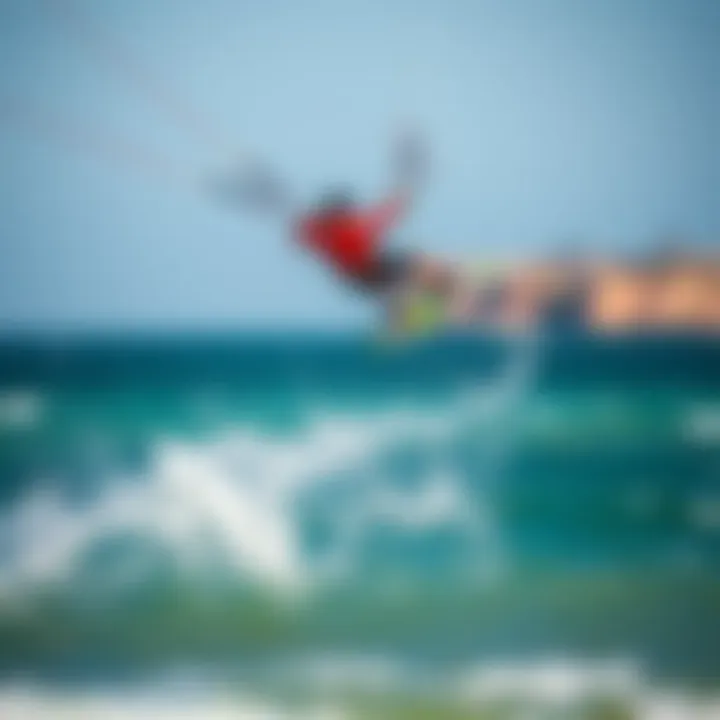
Intro
Kiteboarding, with its blend of thrill and technique, continues to attract a diverse range of enthusiasts. Among the myriad skills one can master, the slingshot maneuver stands out as a quintessential technique that amplifies performance. Understanding this technique is like unlocking a new level in a video game; it not only improves your abilities but enhances your entire experience on the water.
The essence of slingshotting lies in its mechanics, where timing, kite position, and rider maneuverability come together in a harmonious dance. This maneuver has found its place in the repertoire of seasoned kiteboarders and is also accessible to those just starting to dip their toes into this exhilarating sport. As you journey through this article, you will uncover the nuances of the professional slingshot: its mechanics, applications, and critical techniques. This guide is crafted to help you embrace the challenge, enhance your performance, and ensure that safety is never compromised.
Whether you’re at the beach just catching the wind or already carving impressive arcs in the air, this article aims to equip you with the understanding needed to gracefully navigate the slingshot technique and integrate it into your kiteboarding experience.
Gear and Equipment
Before you embark on perfecting the slingshot, having the right gear is crucial. The right equipment not only supports your learning but also enhances safety and performance.
Essential Kiteboarding Gear for Beginners
If you're new to kiteboarding, the array of gear can be overwhelming. Start with these essentials:
- Kite: Choose a beginner-friendly kite, usually with a larger surface area to catch more wind.
- Board: A larger board is more stable and helps beginners maintain balance.
- Harness: Opt for a comfortable waist or seat harness that provides good support.
- Safety Leash: This is critical for disconnecting from the kite when needed.
- Helmet: Protects your head; consider a water-specific design for better floatation.
Having proper gear not only makes the sport more enjoyable but also lessens the risk of accidents.
Advanced Equipment for Experienced Riders
Once you've built your confidence and skills, upgrading your gear can take your performance to new heights:
- High-Performance Kite: Choose kites that are tailored for specific wind conditions and styles.
- Tapered Boards: Lightweight boards designed for maneuverability can help in executing slingshots more effectively.
- Impact Vest: Offers additional protection for those who like to jump or perform tricks.
- Performance Harness: A more advanced harness can provide better distribution of forces and improved comfort during high-intensity maneuvers.
The right equipment not only boosts your performance but also helps you maintain your safety while performing complex moves.
Techniques and Tips
Navigating the waves with skill is all about learning techniques that not only enhance performance but also ensure safety.
Safety Practices for Kiteboarding
Safety should always be at the forefront of your kiteboarding adventures. Here are some practices to consider:
- Always check local regulations and wind conditions before heading out.
- Make sure all equipment is in good condition, with no visible wear or damage.
- Practice with an experienced buddy, especially in the beginning.
- Learn how to properly launch and land kites safely.
It's essential to have a thorough understanding of your environment, as weather conditions and water conditions can change rapidly.
Training Techniques to Improve Your Skills
Improvement in kiteboarding comes with dedication and practice. Here are some effective training techniques:
- Regular Drills: Set specific goals, like mastering turns or jumps, and practice regularly.
- Video Analysis: Record your sessions to identify areas for improvement.
- Consistency: Regular riding will help in perfecting the slingshot technique, integrating it organically into your style.
Routine practice leans heavily towards mastery. It is the foundation upon which skills are built.
"A good kiteboarder makes it look easy; a great one makes it look graceful."
By integrating these tips and techniques, you will not only enhance your skills but also make your kiteboarding journeys more rewarding. The next step in your kiteboarding journey awaits as you grasp the professional slingshot, setting yourself up for a thrilling ride ahead.
Prelims to the Professional Slingshot
The professional slingshot is often seen as the linchpin of advanced kiteboarding techniques, bringing not just a surge of speed but also an exhilarating lift that can define a rider's style. Understanding this maneuver isn’t merely an academic exercise. It’s a journey that can elevate one’s performance from being just another enthusiastic rider to a true master of the sport. This article aims to unpack the intricacies of the slingshot technique, revealing its technical underpinnings and its relevance in different contexts.
Understanding the Basics of Slingshot Technique
To grasp the professional slingshot, one must first understand what it fundamentally is—a technique rooted in effective timing and body coordination. In essence, the slingshot involves a rapid repositioning of the kite to exploit the wind's power to generate lift and speed. Think of it as pulling back on a slingshot, where the potential energy converts into kinetic energy once the tension is released. This analogy speaks volumes to the technique's core essence.
For beginners, mastering the slingshot requires patience and practice. The basic mechanics start with bringing the kite low, generating power. The rider then moves towards the back of the board, shifting their weight decisively to harness the pull from the kite as it rises quickly. This swift motion can propel you upwards, giving that thrilling sensation of flying.
While the mechanics might seem straightforward, it’s the nuance that separates the novice from the experienced. Riders must be attuned to the wind’s shifts and their body’s alignment, making subtle adjustments in real time. Success in executing the slingshot paves the way for more advanced tricks and elevates overall kiteboarding performance.
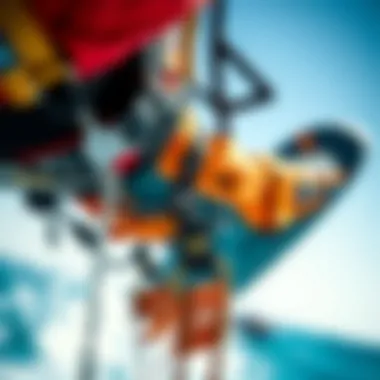
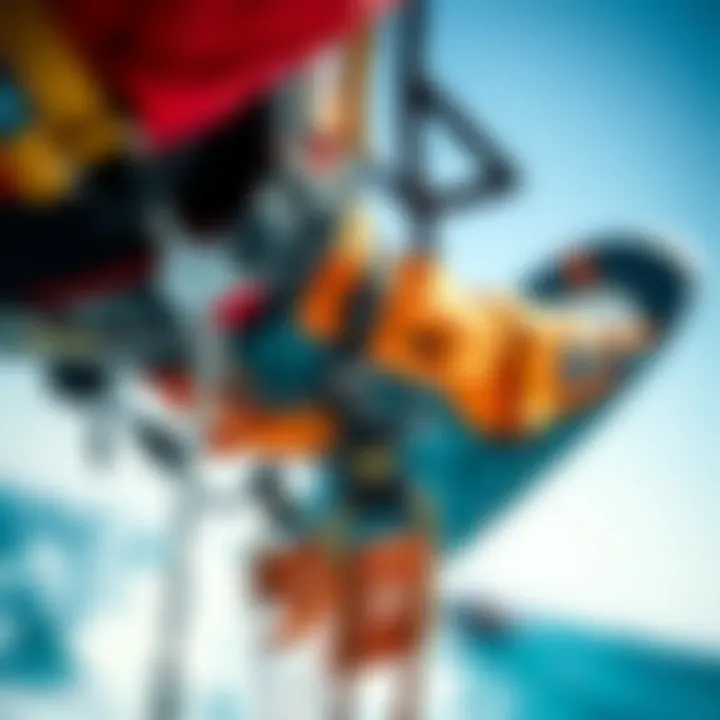
Significance of the Slingshot in Kiteboarding
The slingshot is not just a flashy trick; it serves as a cornerstone in the arsenal of kiteboarders aiming for refinement and control. The power generated through the slingshot can be leveraged in various contexts—from expertly navigating choppy waters to executing complex aerial maneuvers.
In competitive settings, the slingshot stands as a testament to skill and technique. It can be the deciding factor between a successful performance and a mediocre one. Riders who can showcase their ability to execute rapid slingshots often gain an edge over competitors, dazzling judges and spectators alike.
Moreover, beyond competition, the slingshot embodies the spirit of kiteboarding—freedom, adrenaline, and connection with nature. Each slingshot reflects the symbiosis between rider and kite, harnessing the elements for a magnificent, smooth ride.
"The slingshot isn’t merely a technique; it’s a dance with the wind, an expression of one’s mastery over the elements."
As kiteboarding continues to evolve, understanding the role of the slingshot is essential for anyone looking to take their skills to the next level. The technique lays the foundation for continuous development and exploration within the sport.
The Mechanics of the Slingshot
Understanding the mechanics of the slingshot is crucial for both novice and seasoned kiteboarders aiming to master this essential maneuver. The slingshot technique not only enhances speed and power but also allows for a seamless transition between different tricks and maneuvers. Getting a grip on the slingshot mechanics can provide a kiteboarder with a solid foundation to push the envelope in their performance.
Physics Behind the Slingshot
At its core, the slingshot relies on basic principles of physics, specifically Newton's laws of motion. Consider the slingshot as a potent tool that stores potential energy when the kite is pulled back in the wind. When you release it—like a rubber band snapping—the stored energy converts into kinetic energy, propelling you forward. This transformation is what makes the slingshot so potent.
To put it simply, as the kite accelerates forward due to the wind’s force, there is a moment where tension builds. This tension creates a dynamic that enables a kiteboarder to harness significant speed when executed correctly. Wind speed, angle, and kite size are critical variables that must be considered to execute a perfect slingshot.
The effectiveness of the slingshot also has a lot to do with the angle of the kite in relation to the wind. A kite positioned too high or too low might not generate the lift needed to perform the maneuver efficiently. Similarly, the position of the board beneath you as you prepare for execution will influence the outcome. For instance, a stance positioned too far forward can send the rider tumbling, while too far back can result in loss of speed.
Positioning and Body Dynamics
Your positioning and body dynamics during the slingshot execution are nothing short of paramount. The entire maneuver thrives on a series of coordinated movements that flow from one another. As you prepare to launch into the slingshot, ensure that your body is aligned with the board and kite, maintaining an active posture throughout.
- Body Positioning: Stand firmly on your board with your knees slightly bent. This aids in shock absorption upon landing. Your shoulders should be stacked directly above your feet, which helps in steering the kite as you initiate the slingshot.
- Kite Control: Keep the kite low and pull it back using coordinated muscle engagement of your upper body. This is where the real artistry of the slingshot shows itself. When the tension reaches its peak, quickly transition to pushing the kite forward in a smooth, fluid motion.
- Weight Distribution: Shift your weight directly over the board's center. This ensures that you have balance when the kite pulls you and minimizes the risk of falling. If the kite starts to lift you off your board unexpectedly, allow your weight to naturally ride down, making minor adjustments as needed.
The key takeaway is that every movement—be it small or large—has a ripple effect through your performance. Proper positioning leads to better body dynamics, which ultimately enhances control and execution of other tricks in kiteboarding.
"A well-timed slingshot is not just a maneuver; it is a dance between you, the wind, and the waves."
The mechanics of the slingshot add an invigorating dimension to kiteboarding. Recognizing the interplay of physics, positioning, and body dynamics is a giant leap toward mastering this exhilarating sport.
Techniques for Executing the Professional Slingshot
Mastering the professional slingshot in kiteboarding is no small feat. It encompasses not just the act of launching off the water but the intricate dance of preparation, timing, and control that turns a basic move into a thrilling spectacle. Understanding these techniques allows kiteboarders to exploit the full potential of their kite, turning what might be a mere jump into an exhilarating flight. Beyond just aesthetics, each component plays a significant role in the rider's efficiency and safety, as well as their overall performance.
Pre-launch Preparation
Before even touching the water, kiteboarders need to ensure they are well-prepared for the maneuver. This preparation not only includes physical readiness but also a careful assessment of the environment. The following key elements should be in check:
- Equipment Check: Always inspect your gear before hitting the water. Ensure your kite, lines, and board are in prime condition. A malfunction can lead to disastrous consequences.
- Wind Conditions: Gauge the wind intensity and direction. Ideal conditions might be a steady wind that allows you to maintain tension in the lines while also giving enough pull to propel you off the water.
- Positioning the Board: Place your board properly in the water, slightly angled towards the direction of the wind. This positioning helps capture wind efficiently, generating the required lift.
- Mental Visualization: Think through each step of the maneuver. Imagine the sequence you’ll follow to focus your mind, helping minimize the risk of errors during the actual execution.
Timing and Coordination
Timing is the heartbeat of the slingshot maneuver. Without proper alignment and coordination, what was meant to be a smooth execution can transform into a chaotic misfire. Here’s how to nail this crucial facet:
- Launch Timing: As you prepare to jump from the water, it’s vital to pull on the back hand effectively. This will engage the kite, lifting it into a powerful position. Remember, pulling too early or late can fumble the entire attempt.
- Body Movement Sync: Coordinating your body with the kite is paramount. As you begin the jump, lean back slightly and press down against your heels, thereby maintaining a firm grip on both the kite and board. This action promotes balance and control.
- Flow with the Kite: The slingshot motion is akin to a coiled spring. Allow the kite to generate tension as you ascend and then release it at the peak of your jump. The throttle of your body movements against the kite's pull enhances propulsion and height.
Post-execution Control
Once you have soared through the air, landing gracefully is just as critical as the jump itself. Maintaining control post-execution prevents crashes and enhances the overall performance:
- Landing Position: As you prepare to land, keep your knees slightly bent and your body centered over the board. This stance helps absorb the impact effectively.
- Kite Management: After the landing, be cautious with the kite's position. Keep it low and steady to harness the power of the wind. A rapid ascent can destabilize your landing or even flip you over, causing you to lose control.
- Continuous Adjustment: Pay attention to your foot positioning and weight distribution. Adjust your body as needed to maintain equilibrium and prevent a wipeout.
_"Perfecting the slingshot maneuver is not just about the jump; it’s about what comes before and after that truly defines the performance."
Grasping these techniques turns the daring slingshot into a precise art form. It transforms the kiteboarding experience, allowing riders to explore advanced tricks and improvisations. As the winds and waters change, the mastery of these techniques ensures that kiteboarders are always ready to seize the thrill of their next ride.
Safety Considerations
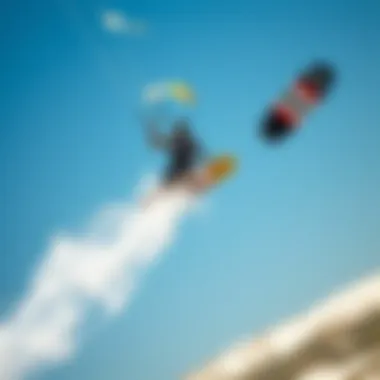
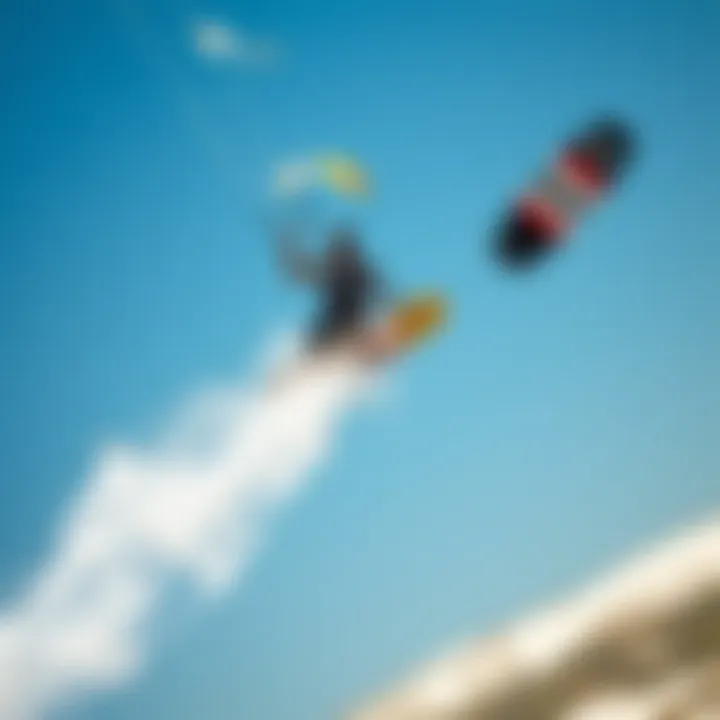
In the exhilarating world of kiteboarding, safety stands as the cornerstone. Engaging in this sport without a solid understanding of safety measures can lead to disastrous outcomes. The thrill of riding the waves and flying high can quickly become a nightmare if environmental conditions, gear quality, and personal safety are not taken into account. Hence, grasping these safety considerations is not merely optional, but essential for ensuring a safe and enjoyable experience on the water.
Assessing Environmental Conditions
Before you even think about launching your kite, take a moment to assess environmental conditions. The ocean is a wild beast; it can change moods faster than you can say "kiteboarding." Things to consider include wind direction and speed, wave height, tide levels, and even the presence of other water users like surfers or swimmers.
Here are some points to keep in mind:
- Wind Strength: Light winds may not provide enough lift, while strong winds can be tricky to handle. Check reliable weather sources or apps like Windy or Windfinder for real-time updates.
- Water Conditions: Look for visibility, current strength, and the presence of obstacles under the water. These features can greatly affect control.
- Time of Day: Early mornings or late afternoons tend to bring more stable winds. Watch out for thermal winds that can occur in the afternoon, as they can be unpredictable.
Always remember, it’s better to be safe than sorry. If conditions seem off, don’t hesitate to postpone your session.
Gear and Equipment Checks
Just as you wouldn’t drive a car with worn-out tires, kiteboarding demands meticulous gear checks. Your equipment is not just your lifeline; it is your key to enjoying the sport completely. A simple oversight can lead to accidents that could have been prevented.
Here’s a checklist to ensure everything is shipshape before hitting the water:
- Kite Integrity: Look for rips, tears, or leaks. A kite can function well with minimal damages, but any significant fissures can lead to catastrophic failures during flight.
- Lines and Connectors: Inspect your lines for frays and kinks. Ensure all connectors, like the leash, are not only secure but in good condition.
- Harness Fit: An ill-fitting harness can cause discomfort and distraction. Make sure yours is snug without being constricting, offering you full mobility.
- Safety Release Systems: Familiarize yourself with your safety release system. Make sure it’s functional and easily accessible in case of emergencies.
Taking the time to conduct these checks can vastly reduce your risks while kiteboarding.
Injury Prevention Strategies
Even with the best safety measures in place, injuries in kiteboarding can still occur. Thus, developing strategies for injury prevention is crucial to prolonging your time on the water.
Here are some effective strategies:
- Progressive Training: Mastering the fundamentals comes first. Only advance to more complex maneuvers like the professional slingshot after becoming proficient with basic techniques.
- Warm-Up Routines: Just like any other sport, warming up your body is key to preventing injuries. Stretching not only enhances flexibility but also prepares your muscles for dynamic movements.
- Know Your Limits: Listen to your body. If you feel fatigued or disoriented, take a break. It’s okay to sit out for a day.
- Stay Educated: Invest time in learning from experienced kiteboarders or taking lessons from qualified instructors. They can offer insights into both advanced techniques and safety practices.
"Kiteboarding combines the thrill of surfing and the excitement of paragliding. Without safety, that thrill can turn into danger."
Incorporating these safety considerations into your kiteboarding practice not only keeps you secure but enhances the overall pleasure of participating in this incredible sport. The ocean is your playground; with a few precautions, your adventures can be as safe as they are thrilling.
For more information on kiteboarding safety, check out Kiteboarding Safety by the International Kiteboarding Association.
Stay vigilant and ride safely!
Common Mistakes and Challenges
Understanding the common pitfalls in kiteboarding, especially concerning the slingshot maneuver, is crucial for any aspiring kiteboarder. These mistakes can not only hinder performance but may also lead to dangerous situations. By pinpointing these errors, riders can refine their technique, enhance their enjoyment of the sport, and increase their safety on the water.
Identifying Mistakes in Technique
When executing the slingshot, many kiteboarders fail to maintain proper body alignment and leverage. For instance, a common error is dropping the shoulder during the pull. This often results in a loss of power and control, making the maneuver less effective. Riders should focus on keeping their shoulders over the board while bending their knees to absorb energy.
Another frequent mistake occurs at the timing of the launch. Some riders might prematurely release tension on the line or apply too much pressure on the kite. This can lead to a loss of elevation or, worse, a crash.
A deeper awareness of body dynamics is required. The rider’s weight distribution plays a significant role in the execution. Leaning too far back can cause the kite to stall, while leaning too far forward can lead to a face-plant.
To summarize, here are some key mistakes to watch out for:
- Improper shoulder alignment
- Incorrect timing when launching
- Mismanagement of weight distribution
Understanding Environmental Challenges
Kiteboarding isn’t solely about technique; environmental conditions can throw a spanner in the works. Wind consistency, direction, and strength can dramatically influence performance. Novice riders sometimes venture out in high winds, thinking they can manage it, only to find themselves fighting against unpredictable gusts.
It’s essential to assess wind conditions before heading into the water. Understanding wind patterns can prevent mishaps. Knowing how to interpret flags on the beach or using smartphone apps to gauge wind speed can be invaluable tools.
Further complicating matters, water conditions also play a role. Choppy water can drastically affect a rider's ability to execute a slingshot. If the waves are too tumultuous, it can lead to instability and ultimately a wipe-out.
To navigate these environmental challenges, consider this advice:
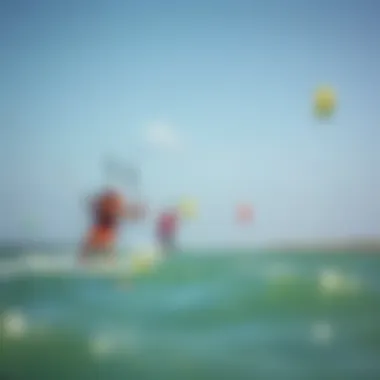
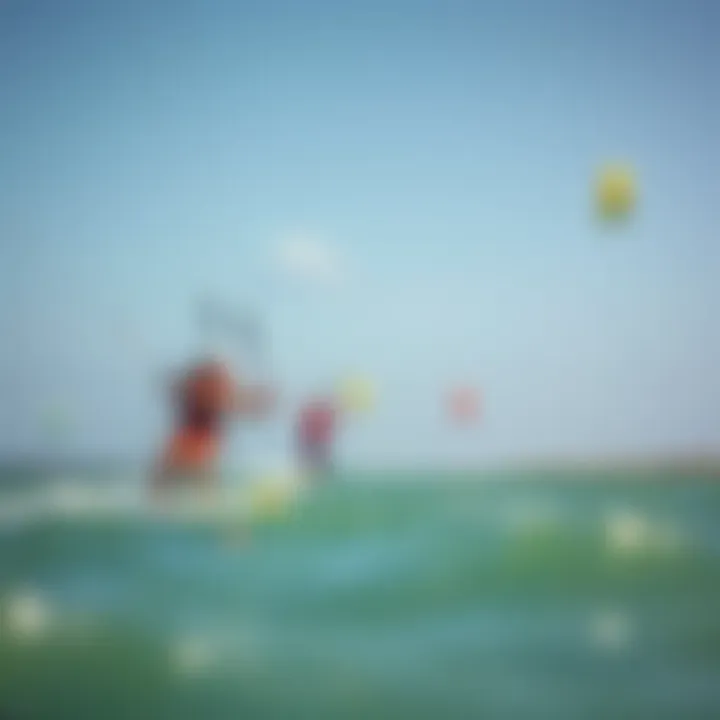
- Always check local weather forecasts.
- Speak with local riders to gain insights on conditions.
- Avoid taking on conditions that push your limits.
"A good rider knows when to ride and when to wait."
By tackling both common mistakes and environmental challenges head-on, riders can develop a holistic understanding of kiteboarding that emphasizes safety and performance.
Enhancing Performance through the Slingshot
In the fluid arena of kiteboarding, the slingshot technique stands as a premier method for boosting performance. By mastering this maneuver, riders not only enhance their speed and efficiency on the water but also unlock a realm of creative possibilities. The impact of effectively executed slingshots is profound, combining better control with increased aerial maneuvers. When executed properly, this technique allows riders to leave the water with a notable elevation, translating to longer and more exhilarating flights. It’s a game-changer that distinguishes the novice from those who dare to push boundaries.
Advanced Techniques for Experienced Riders
For those who have some experience under their belts, advancing from basic slingshot maneuvers to more complex techniques is what truly elevates performance. The goal here is not just to get air but to master the nuances of each movement.
- Precision Timing: It’s essential to find the perfect moment to pull on the harness as the kite lifts. Timing takes practice; miscalculating can lead to an unsatisfactory launch or, worse, a crash.
- Body Positioning: Keeping a low stance while pulling can add speed. Bend your knees, lower your center of gravity, and therefore maximize speed as the kite gets the lift.
- Edge Control: Drive your edge firmly into the water before executing the slingshot. This control sends energy upwards, creating a powerful launch.
These elements contribute to a fluidity that defines skilled kiteboarding. Each rider may find their own rhythm through practice. Often, it's the small adjustments that can make all the difference.
Incorporating Slingshot into Tricks and Maneuvers
The integration of slingshot techniques into tricks makes for a thrilling riding experience. A well-timed slingshot not only enhances jumps but also adds variety to your repertoire, making it easier to combine moves effortlessly.
- Jump Transitions: From a slingshot, you can transition into spins or flips by adjusting your body movement while airborne. This requires a good understanding of how to manipulate the kite's angle and your body’s positioning.
- Seamless Arrivals: Consider how to return to the water. Initiating a slingshot before a landing can increase your control, allowing for a smooth descent while carrying momentum forward.
- Trick Combo: Merging slingshots with other tricks, like the handle pass or board spin, creates even more dynamic display. The sky's the limit when it comes to creative combinations.
Such maneuvers not only demonstrate technique but greatly enhance performance; they serve as critical stepping stones towards achieving professional status in kiteboarding.
"Mastering advanced slingshot techniques is not merely about height, but finesse in execution. Each jump tells a story of skill and dedication."
As riders continue to refine these techniques, gaining insight from observation and practice can turn those awe-inspiring aerial moments into a hallmark of their kiteboarding journey.
The Slingshot in Competitive Kiteboarding
In the realm of competitive kiteboarding, the slingshot is not merely a flashy maneuver; it serves as a cornerstone technique that significantly enhances both performance and scoring potential. It creates an opportunity for riders to harness the kite’s power and transform that into dynamic movements, showcasing agility and control. Within competitions, every second counts, and the mastery of the slingshot can be the difference between a mediocre run and a standout performance.
Contrast Between Recreational and Competitive Use
While recreational kiteboarding is often about fun, chilling on the water, and enjoying the breeze, competitive kiteboarding ups the ante. Renowned for its strict judging criteria, competitions emphasize precision and execution. The slingshot, utilized correctly, can generate impressive speed and height, which are crucial for aerial tricks and smooth landings.
In recreational settings, riders may incorporate the slingshot to simply catch some air for the thrill. In competition, however, this move requires body positioning and kite control that's razor-sharp. Competitors practice extensively to ensure they can execute with precision, as judges look for technical accuracy, style, and the ability to maintain momentum after the slingshot.
"Mastering the slingshot in competition isn’t just about speed; it’s about the grace you show as you navigate the air."
Analysis of Pro-Level Executions
Professional kiteboarders often take the slingshot to new heights—literally and figuratively. By analyzing their techniques, observers can glean the intricate details that elevate their executions beyond the ordinary. For instance, a seasoned competitor will use the slingshot to not only propel themselves into the air but also to transition smoothly into advanced tricks such as rotations and flips.
Key elements observed in pro executions include:
- Timing: Professionals have a keen sense of timing, knowing precisely when to pull the slack in the line to maximize lift.
- Kite Angle: The angle at which the kite is positioned can dictate the power used for slingshot maneuvers. A high angle often produces more lift, while a lower angle can enhance speed.
- Body Positioning: Maintaining a strong yet flexible posture helps in managing the sudden forces experienced during a slingshot. A balanced stance gives the rider better control over their flight path.
- Flow Transition: Post-execution, seamless progression into subsequent maneuvers keeps the energy of the run unbroken, something judges highly value.
Understanding these advanced techniques can greatly aid amateur riders in refining their slingshot abilities, thus inching them closer to a competitive edge. As riders continue to study pro-level executions, they discover that the slingshot is much more than a mere trick; it becomes a vital aspect of their overall kiteboarding strategy.
Ending
As we drift towards the end of our deep dive into the world of kiteboarding's slingshot technique, it's crucial to appreciate the multifaceted importance of mastering this maneuver. From recreational fun to intense competition, the slingshot encapsulates the essence of kiteboarding — harnessing wind and water to elevate performance to new heights.
Recap of Key Points
In reviewing this journey, several key elements stand out:
- Understanding Basics: We began with a solid foundation, getting acquainted with how the slingshot works and why it’s so pivotal in kiteboarding.
- Mechanics: We delved into the underlying physics and the critical positioning and body dynamics required to execute the slingshot successfully.
- Execution Techniques: The importance of pre-launch preparation, timing, and post-execution control was emphasized, showcasing how each step is interlinked in achieving a smooth performance.
- Safety and Challenges: We discussed the potential pitfalls and vital safety considerations, anchoring our knowledge around environmental conditions and gear checks.
- Performance Enhancement: Advanced techniques, along with their application in various tricks, highlighted the versatility and adaptability necessary for skilled riders.
- Competitive Aspects: We contrasted recreational practices with competitive executions, shedding light on the nuances that differentiate weekend warriors from professional athletes.
These layers serve to build a robust understanding of how the slingshot not only enhances individual performance but also contributes significantly to the evolution of kiteboarding as a whole.
Future Directions in Slingshot Techniques
Looking ahead, the future of slingshot techniques in kiteboarding seems brimming with potential. Innovations in equipment — from kite design to board shapes — are likely to unlock new capabilities, pushing the boundaries of what's possible. Moreover,
- Technological Integration: With the rising popularity of wearable tech and data analytics, kiteboarders may start using more sophisticated gadgets to analyze their performance. This could lead to personalized training regimens that focus specifically on refining slingshot techniques.
- Community Engagement: The growth of online platforms, such as reliable forums on Reddit or Facebook groups, holds promise for shared knowledge and new tricks, encouraging collaboration among riders globally.
- Sustainability Focus: As conversations around sustainability in sports escalate, incorporating eco-friendly materials and practices in kiteboarding gear could attract a new demographic, fostering greater awareness of environmental impact.
In summary, the slingshot technique is not just a method; it's a reflection of the dynamic spirit of kiteboarding. With continual innovation and a commitment to safety and performance, kiteboarders are poised to experience their sport in ways not yet imagined. The journey towards mastering this essential skill remains a thrilling adventure for all who dare to embrace the wind and wave.



